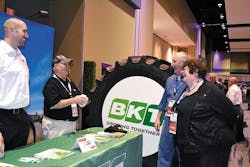As independent tire dealers battle the competition, they often search for the one thing that will help them stand out. At the 2017 K&M Tire Inc. annual dealer conference in Overland Park, Kan., the wholesaler provided a day-and-a-half event full of educational sessions to help dealers identify those opportunities.
The tips applied to every kind of dealer, from those who focus on farm tires to others who depend on consumer tire sales and vehicle service. Here’s a roundup of five key takeaways to improve customer service, and also make more money.
1. Farm tires: Check and adjust the air pressure of tires mounted on new tractors. Chris Neidert, a salesman for Trelleborg Wheel Systems Americas Inc., said when tractors are delivered to a dealership, they usually have 30-40 psi in each tire. Neidert said the tires are filled fuller to make them more stable on delivery trailers. And even though new equipment dealers check over lots of features, Neidert said the tires typically get missed. It only takes a tire dealer a few moments to calculate the correct tire pressure using the weight of the tractor, axle load, the highest speed the farmer intends to drive, and the appropriate load table from a tire manufacturer’s technical manual. There are also mobile apps to do the math. Here’s the formula, which you use twice, once for the front tires and again for the rear tires: Take the tractor’s total weight, multiply it by the percentage of the weight that’s distributed on either the front or rear axle. Divide that number by the number of tires on the axle, and use that figure with a load table to determine the correct pressure. (In the case of dual wheel tires, you multiply the figure by 1.12, which Neidert said is a safety factor to ensure enough air pressure is used.) In one of his examples, the correct tire pressure was 15 psi, less than half the pressure from the new tractor’s delivery. Neidert said making that adjustment will have a huge impact on a dealer’s customer — it will give the tire better traction, provide for even wear, and reduce soil compaction. In the long run, it will save the farmer money, and, “in their eyes, you’ll become the tire professional.”
2. The right focus: Jon Petz is a motivational speaker and magician, and he used some magic to drive home a few points about owning and operating a business. He said there’s value not only in learning new things, but also in “unlearning.” Some practices are meant to be changed, and Petz said “as owners and leaders you need to unlearn” on a regular basis. Petz also said it’s easy for business owners and managers to get too focused on a detail and lose sight of the bigger picture. “Focus is critical, but perspective is priceless.”
3. Service: Kevin Rohlwing, senior vice president of training for the Tire Industry Association, said when it comes to training tire technicians, on-the-job training “is inconsistent, rarely compliant and totally dependent on the knowledge, experience and attitude of the trainer.” And that’s simply not good enough to stand up in court, nor is it sufficient to pass an Occupational Safety and Health Administration inspection, he said. It’s also not a strong enough backbone to make good service a part of a dealership’s brand.
4. Lunch: Rohlwing offered another way to help good service shine at tire dealerships. He knows of a business owner who carries restaurant gift cards in his pocket. When someone in his dealership performs great service he thanks the employee, hands the worker a gift card and says to “have lunch on me.” Rohlwing said dealers should consider the potential impact of rewarding one employee a week with a $10 gift card. “How far can that go for your brand?”
5. TPMS: Servicing a vehicle’s tire pressure monitoring system (TPMS) has never been easier — really, said John Rice, who manages TPMS products and support for 31 Inc. He offered three pieces of evidence: There are universal tools. There are universal sensors covering 90% of vehicles. And even though there are still plenty of varieties, TPMS relearn procedures have gotten easier. On top of that, TPMS is good for business, he said. “You should be checking all the sensors of every vehicle that comes in.” When the federal law mandated TPMS in passenger vehicles 10 years ago, it gave original equipment sensor manufacturers a 20-minute window to warn motorists of a problem. That means a motorist could come into your dealership for an oil change with an existing TPMS problem, but the light isn’t yet shining on the dashboard. ■
About the Author
Joy Kopcha
Managing Editor
Joy Kopcha joined Modern Tire Dealer and Auto Service Professional as senior editor in 2014 after working as a newspaper reporter for a dozen years in Kansas, Indiana and Pennsylvania. She was named managing editor of MTD and ASP in 2022, and took on that same role with Motor Age in 2024.
She is an award-winning journalist, including in 2023 when she was named a Jesse H. Neal Awards Finalist.
Don't miss any of her articles. Sign up for MTD's newsletters.

